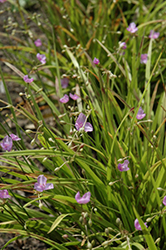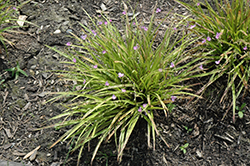It's all about ...
plants

Morning Grace Spiderwort
Callisia rosea 'Morning Grace'
Plant Height: 6 inches
Flower Height: 8 inches
Spread: 8 inches
Sunlight:
![]()
![]()
Hardiness Zone: (annual)
Other Names: Piedmont Roseling, syn. Tradescantia rosea
Description:
This selection is an excellent plant for borders, rock gardens, and massed as groundcover; a prolific bloomer with beautiful lavender-pink flowers accented with bright yellow stamens; narrow mounded foliage is mid-green and attractive
Ornamental Features
Morning Grace Spiderwort has masses of beautiful clusters of lavender flowers with pink overtones at the ends of the stems from mid summer to mid fall, which are most effective when planted in groupings. Its narrow leaves remain green in colour throughout the season.
Landscape Attributes
Morning Grace Spiderwort is an herbaceous annual with an upright spreading habit of growth. Its relatively fine texture sets it apart from other garden plants with less refined foliage.
This is a relatively low maintenance plant, and is best cleaned up in early spring before it resumes active growth for the season. It is a good choice for attracting butterflies to your yard, but is not particularly attractive to deer who tend to leave it alone in favor of tastier treats. It has no significant negative characteristics.
Morning Grace Spiderwort is recommended for the following landscape applications;
- Mass Planting
- Border Edging
- General Garden Use
- Naturalizing And Woodland Gardens
Planting & Growing
Morning Grace Spiderwort will grow to be only 6 inches tall at maturity extending to 8 inches tall with the flowers, with a spread of 8 inches. Its foliage tends to remain low and dense right to the ground. Although it's not a true annual, this fast-growing plant can be expected to behave as an annual in our climate if left outdoors over the winter, usually needing replacement the following year. As such, gardeners should take into consideration that it will perform differently than it would in its native habitat. As this plant tends to go dormant in summer, it is best interplanted with late-season bloomers to hide the dying foliage.
This plant does best in partial shade to shade. It prefers to grow in average to moist conditions, and shouldn't be allowed to dry out. It is not particular as to soil type or pH. It is highly tolerant of urban pollution and will even thrive in inner city environments. Consider covering it with a thick layer of mulch in winter to protect it in exposed locations or colder microclimates. This is a selection of a native North American species. It can be propagated by division; however, as a cultivated variety, be aware that it may be subject to certain restrictions or prohibitions on propagation.

